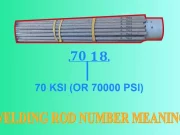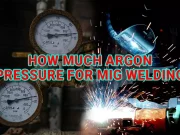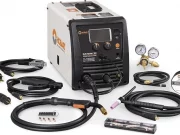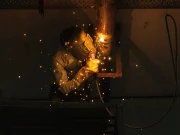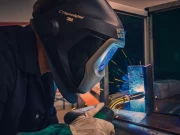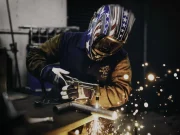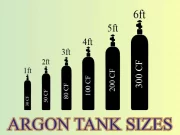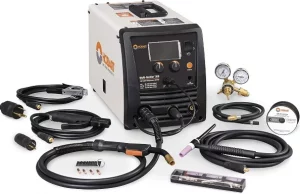TIG welding is a welding process that produces a weld using a tungsten electrode. Welders use this method to welding small and thin pieces of metals like aluminum.
TIG welding produces welds with a precise and stylish appearance. In addition, TIG welding possesses an inert gas (usually argon or helium) that protects its electrode from oxidization.
Welders use TIG welding for many purposes. If you’re seeking knowledge on the uses of this welding process, keep reading.
What Is The Use Of TIG Welding?
We use TIG welding to weld thin metals with tensile strength within the 5000 range. TIG welding is also suitable for welding materials like copper, titanium and aluminum.
It’s also crucial to know that other types of welding don’t work on such thin materials.
We use TIG welding for jobs that require good bonds and a stylish appearance. You can also use TIG welding to repair jewelry. TIG welding also has many applications in site repairs and assembling, and production lines.
About TIG Welding
TIG is an acronym for inert tungsten gas. The more elaborate name for TIG welding is gas tungsten arc welding (GTAW).
A tungsten electrode produces the current used to weld the materials together in TIG welding.
You can perform TIG welding when the tungsten electrode provides an efficient current that enables welding with a welding arc.
At the end of a TIG welding process, an inert gas cools the tungsten and weld puddle. The choice of inert gas is to ensure welder’s safety and protection.
TIG welding, in many ways, bears semblances with oxy-acetylene welding. Both methods use filler materials to reinforce welding corrections.
TIG is perfect for completing tricky projects like curves or rounding off any metal project.
TIG welding operates using a DC as its primary power source. However, welders can use an alternating current to weld aluminum.
Parts Of A TIG Welding Machine
Let us look at the essential parts of a TIG welder.
The work lead:
The first important part of a TIG welder is the work lead or the ground cable.
You can identify a work lead by the presence of an electric TIG touch at the end.
A cable that carries argon or other inert gases connects to the work lead.
The work of the inert gas is to coat and protect the weld from getting contaminated by outside air.
The small tungsten rod:
The TIG rod is a tiny electrode present in the TIG torch, and it comes in different sizes.
This electrode burns like a filler rod. You can sharpen it into either a point or ball, so it can match with what you are welding.
The copper collet:
A copper collect helps to hold the tungsten in place. You can also use the copper collect to adjust the length of the tungsten, as it usually tends to stick out of the welder’s cup.
You can unscrew, remove and replace the ceramic cup in the copper collect whenever the need arises.
You will find cup outlets of various diameters of the cup outlets are in the market. You must use the one that matches with the material to produce a good weld.
There are many holes on the body of the copper collect. Their function is to allow the movement of gases into the cup to circle the tungsten.
If you want to reduce the collect’s grip on the tungsten, try losing the black cap on the collect.
Foot-operated mechanism:
The foot-operated tool of a TIG machine enables welders to choose between different amperage settings.
Welders who are working on alloy steels usually find this part quite helpful.
It allows them to turn up the heat slowly and then gradually reduce l when they need to.
This mechanism helps to prevent thermal shock to the metal. Thermal shock can make the metal brittle after welding.
Controls:
You will find many types of electric controls on the TIG machine.
The most important control is the balancing control.
The balancing control is essential when welding aluminum as it helps keep the cleaning versus penetration of the aluminum at a minimal amount.
The higher the TIG machine balance, the deeper the welds penetrate the metal.
Another control found on the TIG machine is the standard or pulsed mode controls.
This control helps to keep the amperage varied while welding aluminum. This control helps to turn down the heat on the work piece to produce a better weld.
You can use pulse controls to give welds a “stacked dime” appearance. You can also create a wave-like pattern on your welds.
Advantages Of TIG Welding:
TIG welding comes with many benefits.
- Welders have more control with the TIG electrode so that they can produce delicate and precise welds.
- TIG welding produces reliable and high-quality welds.
- With TIG welding, welders have more control over the electrode.
- With TIG welding, you can work with or without filler wire, depending on the final application of the welder.
- TIG welding produces little or no smoke or residue and therefore reduces air pollution.
- TIG welding has a wide range of applications. You can use this type of welding on most metals, even those with heterogeneous basic materials like stainless steel, titanium, magnesium, aluminum and copper.
- You will rarely find welding defects on welds made using TIG welding.
- Because welders have more control in TIG welding, beginners can quickly get the hang of it.
Disadvantages Of TIG welding
Some drawbacks of TIG welding include:
- Although TIG welding produces welds of superior qualities, TIG welding equipment is relatively expensive compared to other types of welding.
- The TIG welding process can take a long time to complete.
- TIG welding machine requires more energy.
- You will need a cleaner environment for TIG welding jobs as contaminants can affect the quality of work.
What Are The Steps Involved TIG Welding Project?
Outlined below are some steps that welders use to carry out a TIG welding project.
Step 1: Select a suitable electrode
The first step in TIG welding is to select a suitable electrode. For aluminum welding, a pure tungsten rod is the best electrode to use.
Step 2: Get the electrode ready
To get the electrode ready, you will have to grind the end of the tungsten rod to get a perfect point.
You can do this if the electrode is brand new and is not pointed or rounded at the tip.
Handy Tip:
For a rounded rod tip, welding is better with an alternating current. For a pointed rod tip, we recommend you use a direct current.
Step 3: Place the electrode in the collet
To do this, first, unscrew the electrode holder. Then, insert your electrode and screw it back.
Step 4: Select preferred settings
For a TIG welder, three options are available on the settings. They are the DCEP, DCEN and AC settings.
DCEP refers to “DC electrode positive” and is suitable for stick welding.
DCEN refers to “DC electrode negative” and is suitable for welding steel.
Like we mentioned earlier, AC is best when welding aluminum.
Step 5: Get your gas ready
To weld aluminum, use pure argon gas. However, you can use a mixture of argon and carbon dioxide is to weld steel.
Step 6: Get your metal and welding table ready
The material to be weld would benefit from a sizeable metallic area to enable the flow of electricity through the material.
You can use a welding table for this purpose. However, in the absence of a welding table, a large flat sheet of metal will suffice.
Remember to keep the table’s surface or metal sheets clean if you want to make top-quality welds.
Step 7: Get geared up
The welding job comes with its hazards. So while you want to do a good job, your safety is also essential.
For safety purposes, you must wear adequate gear.
They include thick leather gloves, welding helmets, closed-toe shoes, welding coats, and flashlights.
Step 8: Final checks
Before you start welding, ensure the electrode is moving freely and will be easy to use. To do this, place the electrode on your dominant hand and touch it against metal.
Step 9: let’s get ready to weld!
If you followed the steps outlined above, then your TIG is ready to weld.
Start by placing the electrode about an inch away from the metal you want to weld.
Conclusion
Welding is a fabrication process that that blends two or more materials by using heat or pressure.
TIG is an acronym for inert tungsten gas. The more elaborate name for TIG welding is gas tungsten arc welding (GTAW). You can use TIG welding to weld thin metals with tensile strength within the 5000 range.
TIG welding is also suitable for welding materials like copper, titanium and aluminum. We use TIG welding for jobs that require good bonds and a stylish appearance.
You can also use TIG welding to repair jewelry. TIG welding also has many applications in site repairs and assembling, and production lines.
TIG welding operates using a DC as its primary power source. However, welders can use an alternating current to weld aluminum.
Welders have more control with the TIG electrode so that they can produce high-quality and precise welds. Though produces welds of superior qualities, TIG welding equipment is relatively expensive compared to other types of welding.




